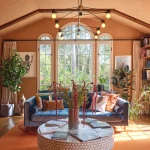Kashef Mahboob Chowdhury is a notable architect from Dhaka, Bangladesh, we profile his life and work…
Kashef Mahboob Chowdhury is a notable architect from Dhaka, Bangladesh and the winner of the Aga Khan Award for Architecture 2016. He graduated in architecture from the Bangladesh University of Engineering and Technology (BUET) in 1995 and, after working with architect Uttam Kumar Saha, he established the practice URBANA in partnership in 1995 and, from 2004, has continued as the sole principal of the firm.
He is married to Rajrupa Chowdhury, an Indian classical musician of the instrument Sarod. They have a son, Rayan Mahboob Chowdhury. Chowdhury has a studio-based practice whose works find root in history with a strong emphasis on climate, materials and context – both natural and human. Projects in the studio are given extended time for research to reach a level of innovation and original expression. Works range from the conversion of ships and low-cost raised settlements in ‘chars’ to training centres, mosques, art galleries, museums, residences and multi-family housing to corporate head offices.
Chowdhury has been a visiting faculty member at the North South University and BRAC University, both in Bangladesh. In 2006, he attended a Glenn Murcutt masterclass in Sydney, Australia. He has twice been a finalist in the Aga Khan Award for Architecture and won first prize in Architectural Review’s AR+D Emerging Architecture Award 2012.
Chowdhury takes an active interest in art and in 2004 presented a lecture series Aspects of Contemporary Art in Germany at the Goethe Institut, Dhaka. He has worked as a professional photographer and has held seven solo exhibitions. He has designed and published three books: Around Dhaka, 2004; Plot Number Fifty Six, 2009 and The Night of Fifteen November, 2011 – a photographic and recorded account of some survivors of the cyclone SIDR in the coastal areas of Bangladesh.
“In his studio, time is held in high regard, so much so that until recently he deliberately resisted using any form of artificial light, choosing instead to operate the business during daylight hours. This was done to enforce a natural pattern to the working day, and to encourage people not to work excessively long hours, and while changes to this routine were perhaps inevitable, Chowdhury maintains his respect for time, stating his desire to separate his studio from the influences of ‘the passing world’ to avoid ‘rushing through the design process’, and to always remember that ‘time is of the essence’.” and was nominated for the Aga Khan Award for Architecture 2010 for designing the Chandgaon Mosque in Chittagong.
Some of his notable awards and recognitions are:
Winner, of Architect of the Year Award (AYA) for Focus Countries, India, 2013
Winner, AR+ Emerging Architecture Award, UK, 2012
Winner, Institute of Architects Bangladesh (IAB) Design Award, Bangladesh, 2010
Finalist, The Aga Khan Award for Architecture, Switzerland, 2010
Honorary mention, Institute of Architects Bangladesh Design Competition, Bangladesh, 2007
Second prize, Nishorgo Visitor’s Center, Bangladesh, 2006
Finalist (with Marina Tabassum), The Aga Khan Award for Architecture, Switzerland, 2004
First prize (with Marina Tabassum), National Independence Monument Design Competition, 1996
Contact Details
www.kashefchowdhury-urbana.com




GIPHY App Key not set. Please check settings